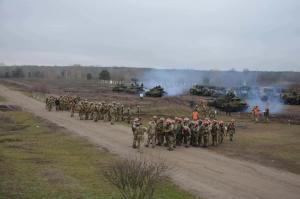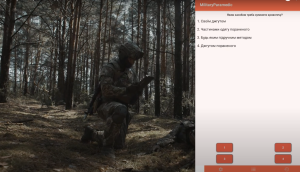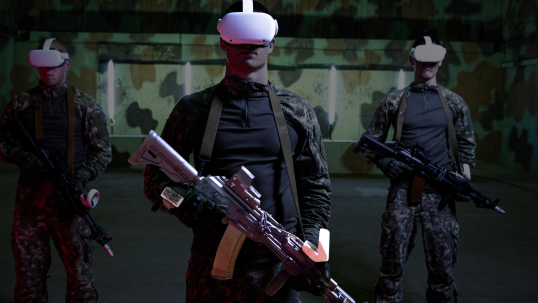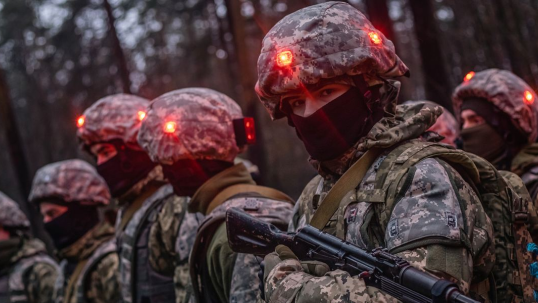
SKIFTECH full-cycle simulation systems manufactured in Ukraine are used for tactical military training. Today, the SKIFTECH range of products includes over 20 tactical simulators, which can be used to conduct tactical training for any land unit with up to 1,000 Individual Weapon Systems, armored vehicle kits, or other simulators.
A new approach to tactical training

Before the Armed Forces of Ukraine received tactical simulators, tactical training boiled down to individual training and testing of the soldier’s knowledge of combat theory and organization, as well as measures and methods of combat.
Unit coordination is one of the key pillars of tactical training. This process was rather theoretical than practical without simulators, as there was no convenient tool to track the statistics and performance of both individual soldiers and the entire unit. Moreover, coordination activities were always conducted for specific units, with no simulated enemy. Fire contact could only be simulated while playing paintball or hardball.
The approach to tactical training has drastically changed since the introduction of SKIFTECH simulators in Ukrainian training centers. During the training sessions, instructors began to simulate full-scale infantry and tank battle scenarios using grenade launchers and ATGMs, as well as anti-personnel and anti-tank mine simulators. Since all simulators operate in the same ecosystem, instructors can track real-time movements, the number of simulated shots, and damage to infantry, armored vehicle crews, and ATGM fire team.
Realistic scenarios and advanced training

When developing simulators, SKIFTECH specialists collect information from active military personnel and combatants. This feedback enables us to implement only relevant and useful features and settings into the simulators and software. A variety of settings gives the simulator a wide range of scenarios for training.
As an example, personal kits for infantry soldiers can be used to conduct full coordination within units and practice the following tactical training basics:
- Techniques and procedures of the unit movement;
- Crossing roads and dangerous areas;
- Reaction to front and flank contact;
- Movement through a minefield;
- Planning and conducting an ambush, sabotage, or raid;
- Movement in the city and under buildings;
- Approaching a building to storm it;
- Working in several groups, etc.
Tactical training kits for armored vehicle crews (tanks, APC, IFV) allow them to be engaged not only in exercises involving infantry but also to practice independent scenarios involving only armored vehicles. Typically, training is held for 8 armored vehicle crews at a time in such scenarios:
- Ambush
5 units of armored vehicles from one team simulate an escort guard at the training ground, and 3 units of armored vehicles carry out a simulated ambush attack. The tank crews improve their actions when defending an escort. It is also possible to train crews in a simulated attack on an escort guard by taking up and disguising positions and distributing fire.
- Assault on a settlement
2 units of armored vehicles defend a simulated settlement, and 6 units of armored vehicles storm it. The crews improve their skills in detecting, moving, and attacking the settlement. This scenario can also be used to train local defense.
- Head-on fight
8 units of armored vehicles are divided into two nominal teams that take up positions on the training ground. Following the start command, the crews begin to move, keeping in mind the terrain of the training ground, detecting and defeating the simulated enemy. This is the scenario used by our clients to arrange annual competitions for the title of “Best Crew in the Country”.
Such scenarios can be used by:
- Firing pointers to improve their skills of interaction with standard devices for target detection;
- Commanders to improve their skills in commanding a tank platoon;
- Motor driver mechanics to improve their armored vehicle driving skills.
Training of military medics

The SKIFTECH team has even devised a solution for training military medics that is also used by other military personnel. One of the trainees, who is assigned a “medic” role, receives a tablet with software from SKIFTECH. In case of a simulated injury of any soldier during the training, the medic has to find the wounded soldier and use the SKIFTECH app to answer the questions about first aid depending on the simulated injury of the soldier. If the medic answers the question correctly and theoretically provides the necessary aid, the instructor sees this and may reactivate the soldier’s personal kit to allow the wounded to continue training.
Conclusions

SKIFTECH simulators have become a vital element of tactical training for Ukrainian military personnel both for recruits and experienced soldiers with real combat experience. As the full-scale invasion has begun, the equipment is being used even in the near-front zone. Our defenders are training daily on proven equipment and requesting the development of new types of simulators for weapons supplied from abroad.
Personal kits or sets for military equipment allow you to conduct training as close as possible to real combat actions by using regular small arms, armored vehicles, pyrotechnics, and sound effects. By replacing training involving physical ammunition with SKIFTECH tactical simulators, the monetary and material costs of training are significantly reduced:
- Ammunition for guns and machine guns
- Maintenance of fire control systems and loading machines.
The above factors ensure that SKIFTECH is the main and most widespread supplier of training simulation systems in Ukraine.

